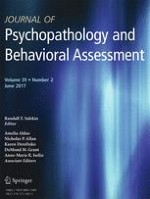01-08-2016
Negative Halo Effects in Parent Ratings of ADHD and ODD
Gepubliceerd in: Journal of Psychopathology and Behavioral Assessment | Uitgave 2/2017
Log in om toegang te krijgenAbstract
Parent ratings of ADHD and ODD symptoms depicted in written vignettes were examined for negative halo effects. Participants were 82 parents of children ages 6–12. Both unidirectional and bidirectional halo effects were found but to a lesser extent than in similar studies with teacher and college student raters. Specifically, parents were more likely to: (a) rate a child as inattentive in the presence of hyperactivity symptoms; (b) more likely to rate a child as oppositional in the presence of inattention and hyperactivity symptoms; and (c) more likely to rate a child as inattentive and hyperactive in the presence of oppositionality symptoms. Several specific symptoms were also found to be particularly susceptible to halo effects. Results suggest that parents may be more discerning raters of disruptive behavior disorders than teachers or college students and less prone to negative halo effects. Implications for clinical practice and future research directions are discussed.
